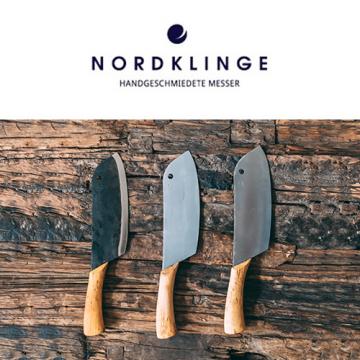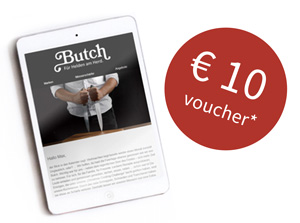
Nordklinge Knives
A piece of steel and a wooden handle. Together they make a knife, very simply put. At Nordklinge, this is the essence, the essential, of what a chef's knife is all about. Nordklinge knives are hand-forged in Finland from carbon steel and refined by a German master. This unusual combination of Finnish blacksmithing and German quality work results in a successful synthesis: high-quality chef's knives of exceptional sharpness and breathtaking vintage look in robust craftsmanship. Genuine, honest, reliable.
At first glance, a Nordklinge knife inevitably brings to mind tools from the Stone Age – and that's intentional. Archaic knife shapes, rough-looking blades, simply shaped wooden handles. Nordklinge aims to set a counterpoint with its knives, to stand out from overly perfect knife collections, crafted to the hundredth of a millimeter, where one knife is exactly like the other. For Henrik Terschüren, the man behind the brand Nordklinge, such knives are anonymous utility objects. He loves cutting tools with personality, with which a relationship develops, and with which working is a true pleasure. Nordklinge knives transport us to times long past, they awaken the longing for the genuine, the unadulterated, and if you own a "Vankka," you are indeed a little proud of this extraordinary piece. "Vankka" is Finnish and means "solid." This is also one of the best product descriptions for this knife brand. Nordklinge does not claim to make the very best knives in the world. However, if you value an unusual appearance that aligns with inner values, if you find handcrafted items beautiful and desirable and are willing to accept a higher maintenance effort, then Nordklinge knives are a good choice.
Butch April Promotion: 15% off all knives from the Nordklinge brand
Note: We have already reduced the item prices. The promotion is valid until 05/04/2025.
The Production of Nordklinge Knives
Nordklinge knives are handcrafted in Finland by an award-winning blacksmith (his emblem is exclusively found on the blade). The refinement of the knives with "extra sharpening" is carried out in Germany by the Kubesch grinding workshop in Fulda, a master craftsman business with a long-standing tradition. For the Nordklinge brand, the unusual combination of Finnish blacksmithing and German quality work is a successful synthesis that the company is proud of. Henrik Terschüren also places importance on fair dealings with manufacturing partners, as he believes the name Nordklinge should stand not only for exceptional knives but also for sustainable top craftsmanship from the EU.
The Suitability of Nordklinge Knives
The blade silhouette of the "Vankkas" is based on traditional forms and is inspired by both European and Asian designs. This results in true all-rounders. All-purpose chef's knives that are suitable for a wide range of cutting tasks in the kitchen. The wide blade allows for safe and comfortable cutting, whether it's raw or cooked meat or delicate fish. Vegetables can be effortlessly chopped, and the pointed shape of the knife blades is useful for opening and coring, for example, peppers. However, at least the knives in the "extra sharpening" category do not take kindly to one thing: Even though Nordklinge knives resemble cleavers, they are by no means intended for chopping - for example, bones - and the blade would suffer irreparable damage. Frozen foods and woody herb stems are also off-limits for a Vankka with extra sharpening.









